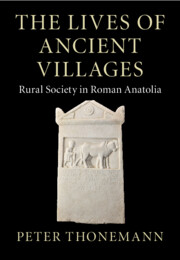Book contents
- The Lives of Ancient Villages
- Greek Culture in the Roman World
- The Lives of Ancient Villages
- Copyright page
- Contents
- Figures
- Tables
- Preface
- Abbreviations
- Maps
- 1 Hieradoumia
- 2 Commemorative Cultures
- 3 Demography
- 4 Kinship Terminology
- 5 Household Forms
- 6 The Circulation of Children
- 7 Beyond the Family
- 8 Rural Sanctuaries
- 9 Village Society
- 10 City, Village, Kin-Group
- References
- Index
4 - Kinship Terminology
Published online by Cambridge University Press: 28 October 2022
- The Lives of Ancient Villages
- Greek Culture in the Roman World
- The Lives of Ancient Villages
- Copyright page
- Contents
- Figures
- Tables
- Preface
- Abbreviations
- Maps
- 1 Hieradoumia
- 2 Commemorative Cultures
- 3 Demography
- 4 Kinship Terminology
- 5 Household Forms
- 6 The Circulation of Children
- 7 Beyond the Family
- 8 Rural Sanctuaries
- 9 Village Society
- 10 City, Village, Kin-Group
- References
- Index
Summary
Hieradoumian epitaphs very often include lengthy lists of family members as co-commemorators of the deceased. As a result, the kinship terminology of Roman Hieradoumia is known to us in extraordinary detail. This chapter offers a full analysis of the region’s kinship terminological system, which turns out to have been richer and more complex than any other known from the Greco-Roman world. Matrilineal and patrilineal kin were clearly distinguished, as were different categories of affines. Although Hieradoumian kinship terminology shows close analogies with that employed in the Homeric epics, this was certainly not a matter of artificial archaizing, as is shown by the distinctive morphology and semantic range of certain Hieradoumian kinship terms (hykeros, ianatēr, kambdios). This terminological complexity is fundamental for our understanding of Hieradoumian social structure, which – or so it is argued here – was essentially kin-ordered.
- Type
- Chapter
- Information
- The Lives of Ancient VillagesRural Society in Roman Anatolia, pp. 103 - 145Publisher: Cambridge University PressPrint publication year: 2022

